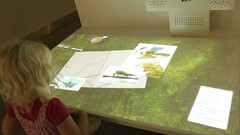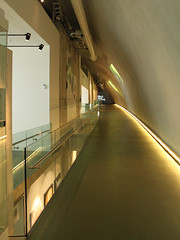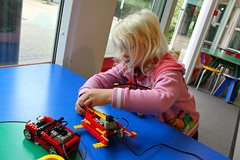In the first part of our Countdown to Big School, my daughter and I covered Art and Science, and in part two we’ll be looking at Biology and History…
London’s Natural History Museum is a truly amazing place. The building itself is worth a visit alone just to see the craftsmanship employed in its construction, but when you add the fact that it’s free to get in you have a day out full of win.
We came for the Butterfly Explorers exhibit which was running out on the lawn and did have an entrance charge, but it was well worth it to actually see a butterfly emerging from its chrysalis as that’s something I’ve never seen myself before. However I think the little lady was more more interested in the little ‘Passport’ she was given and getting it stamped as we crossed the borders of the ‘continents’ inside the super humid butterfly house.
The staff around knew their stuff and were happy to take some time to explain the difference between a cocoon and a chrysalis and all about the wonder of metamorphosis. One even picked up this fantastic looking Luna Moth to explain why it has the extra long, dangly wings for us – apparently when it’s flying, they make the moth seem much larger to a bat’s sonar!
Then of course there was the ubiquitous exit-into-the-shop where various butterfly themed paraphernalia was duly purchased and then it was onwards to the main building.
Once you walk through the enormously impressive doors of the museum itself you are greeted by a magnificent diplodocus skeleton. Ordinarily, we would have spent a while wandering around looking at everything the main hall can offer, including the animatronic T-Rex, but this time we were on a mission to see the newest part of the museum – the Darwin Centre and a different kind of cocoon from the ones we’d seen earlier.
The Darwin Centre is the biggest expansion of the museum in nearly 130 years, when it first moved to its current location and it’s certainly a very impressive structure. Inside the giant glass cube is a 65-metre-long, 8-storey-high cocoon, designed by Danish architects C F Møller, which took 25 months, 280 people and a £78 million to build. The Cocoon houses not just state of the art interactive educational exhibits, but also the museum’s most valuable specimen collections and is a working building, with several rooms visible to the public where you can see the actual scientists doing their sciencey things.
You enter the cocoon on the 7th floor after ascending in the glass lift. In the lobby area there are several touchscreen monitors embedded in the tables and it’s here that you are first introduced to the ‘Nature Plus‘ system. You are encouraged to pick up a card with a unique barcode and number on it and the idea of the system is that as you go around the cocoon you can scan your card at the various screens and collect info which you then access online later, just by registering your number.
Once you enter the sleek, hand-polished plaster of the cocoon you are presented with huge photos of bugs and plants all over the walls and ‘interesting’ shapes projected on the curved ceilings. As you descend slowly around the outside edge of the cocoon (no steps, just a gentle incline) you pass by numerous interactive screens, all enticing you in to have a play with short clips of video. All of the video are presented by members of staff, not drafted in actors, so some of the acting is a bit wooden, but at least you know that they know what they’re talking about.
We decided to have a go at planning a field trip to Scotland to collect some Robber Flies. The presenter appeared on the small flatscreen and gave us an overview of the task at hand, before transferring us to the action on the touchscreen and getting us to select the equipment we’ll need by placing it in a holdall. It’s not just any old touchscreen though, it’s a flat white table and the images are projected down onto the surface from above. First of all they wanted to take a photo for our passport and this was the giveaway that it was designed for kids older than 4 – I had to lift her up for it to snap the shot, but we got there after a couple of tries.
The touch-table itself takes a bit of getting used to as there can be a bit of lag between touching the surface and actually ‘moving’ the item, but it didn’t seem to be a problem for the Geeklet – two years of playing with an iPhone has taught her so much ;o). You choose which items to take from a few laid out on the table, using your judgement as to which option would best suit the task of catching flies – for example; what would be the best way to bring the flies back to the lab, a plastic bag or a glass jar? Once you’ve made your choice you simply touch it on the table with your finger and move it over to your holdall and drop it in.
After you’ve packed your bag, you’re off on the expedition to see if you’ve got everything right and the story played out with a couple more videos. We got a couple wrong so we were given the ‘ooo, maybe the other thing might have been a bit better’ spiel and then our expedition was over and we returned to the museum empty handed, but not before they let us email a postcard from the Highlands of Scotland using the touch-table again. At the end of our little session, we were prompted to scan our Nature Plus card so we could review the information later.
We continued on and found several more screens (with more Nature Plus scanners) and photo sections with huge electron microscope images of bugs which, far from being scared of, the four year old actually thought were cute, especially the butterfly with it’s coiled tongue. There was even section where you could ask a real live scientist questions, but unfortunately they must have been on their lunch break when we went past. We exited the cocoon over a walkway and descended back to the ground floor to continue looking around the fantastic museum.
When we got back home, I was eager to sign up on the Nature Plus website and see exactly what we had collected around the cocoon. After entering our unique number, we were taken to the landing page where we could see headers for the items we had collected as well as links to all of the other features of Nature Plus. I was very disappointed with our collected content – somehow there was nothing about our expedition activity, maybe we didn’t scan the card properly? Other areas were simply links to existing sections of the NHM site – some requiring “Netscape Communicator versions 4.5 to 4.8” as a suitable browser (!), others needing you to install Microsoft Silverlight (which I refuse to do on principle). Eventually, after a bit of digging, I was able to find some of the video content, but by this point my little adventurer had gone back to her Barbie dolls.
What seems to be of much more use, especially for older children and schools, is the growing online community that has been built up around Nature Plus. Once you’ve registered you can access the various forums, communities and projects based around a variety of science and nature topics. Here you can ask experts questions, identify bugs, write your own blog posts, upload and share videos and join in the debates. It looks like a fantastic resource for schools and a kind of specific mini-wikipedia of knowledge.
Maybe we’ll revisit it when the little one isn’t so little.
Wrapping up our final few days before school started, we made the most of our Merlin cards – the UK’s super annual pass system – which give you entry to the best theme parks and attractions in the country. One day we did the London Aquarium and the Eye and as we’re lucky enough to live almost equidistant from three of the best theme parks here the UK – Thorpe Park, Chessington World of Adventures and Legoland, it would be rude not to pay them a visit too.
The little one is just starting to develop a taste for the adrenaline fuelled thrill of rollercoasters, so it was great to be able to ride them without having to queue, sometimes we could even just stay on for another go. The coasters, swingboats, dodgems, driving schools and bouncers were all good fun, but I think we had the best time in one of the building rooms at Legoland.
We haven’t made use of them much in the past, but on this trip the weather was a bit rainy so it seemed like a good place to hang out until the clouds passed. We were able to select a kit to build and given a battery pack for the motorised ones and shown to a little table. You don’t get that same feeling of opening a brand new box of crisp blocks, but there’s still some excitement to be had in hunting down the pieces and although the skill level required was way beyond a four year old, she kept going back for more and more kits. By the third or fourth one, she was able to assemble parts of them all by herself, so long as I’d already found the required pieces.
We’re now in to the second full week of school and she’s settling in nicely, but as soon as the first Wednesday (our old play day) came around, she was all tearful and didn’t want to go as she wanted “to do something with you today, Daddy.”
That broke my heart, but at least it’s only a couple of weeks till the holidays now…








